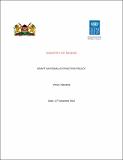| dc.description.abstract | The overarching policy direction on the extractives sector is contained in the second Medium Term Plan (MTP) of Kenya’s Vision 2030. Kenya’s Vision 2030 has included oil, gas and other mineral resources as the seventh priority sector with a high potential of spurring the country’s economic growth and development. In the vision’s Medium Term Plan (MTP), covering the period 2013-2017, key flagship progress has been made in the review of the legal and regulatory frameworks and institutional restructuring in the extractive sector such enactment of the Mining Act 2016, Mining and Minerals Policy 2016 and drafting of the Energy Bill and Energy and Petroleum Policy that proposes several institutions for the management of oil and gas. However, there is need for an overarching extractive policy that bring the entire sector together in the management of extractives. Experience in other parts of the world such as Nigeria, the Democratic Republic of Congo (DRC), South Sudan, Liberia, Sierra Leone, Angola and the Central African Republic (CAR), suggest that extractives if not well managed can be a curse leading to violent conflicts, volatile economic growth due to fluctuating commodity prices; limited job creation; corruption; environmental degradation; gender violence; relocation of families to make way for extraction of natural resources; and spread of HIV and AIDS among communities impacted by extraction activities among others... | en_US |

